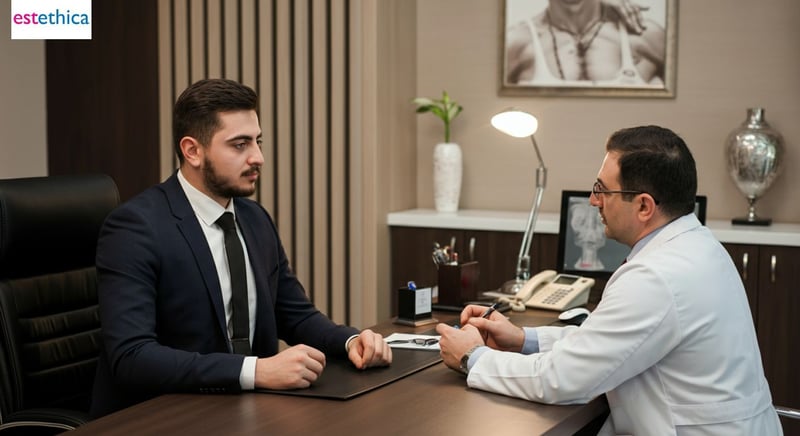Conquer Gynecomastia: Effective Solutions for Men
Tackle gynecomastia with expert advice and treatment solutions at estethica. Discover recovery tips to ensure a smooth post-surgery experience.
Conquer Gynecomastia: Effective Solutions for Men
Gynecomastia, commonly referred to as enlarged male breasts, is a condition that affects numerous men worldwide. Understanding the underlying causes is crucial for effective management and treatment. This comprehensive guide provides insights into various treatment options, from natural methods to surgical interventions, aiming to equip you with the knowledge required to tackle this condition confidently. Embrace the journey to better health and well-being as we explore viable solutions to conquer gynecomastia.
Understanding the Causes of Enlarged Male Breasts
Hormonal Imbalances and Their Impact
Gynecomastia, or the enlargement of male breast tissue, is primarily caused by hormonal imbalances. An increase in estrogen or a decrease in testosterone can lead to this condition. For instance, during puberty, hormonal fluctuations are common, and some boys may experience temporary gynecomastia. Similarly, older men might face this issue due to declining testosterone levels. Certain medications, such as those for heart conditions or prostate cancer, can also contribute to hormonal imbalances, exacerbating gynecomastia. Understanding these factors is crucial in identifying the root cause and exploring potential gynecomastia treatment options.
Common Causes of Hormonal Imbalance
- Puberty: Temporary hormonal changes can lead to gynecomastia in adolescent boys.
- Aging: Natural decline in testosterone levels in older men can cause breast tissue enlargement.
- Medications: Drugs for heart conditions or prostate cancer may disrupt hormonal balance.
These examples highlight how various life stages and external factors can influence hormonal levels, potentially leading to gynecomastia.
Steps to Address Hormonal Imbalance
- Consult a healthcare professional to evaluate hormone levels and identify imbalances.
- Consider lifestyle changes, such as diet and exercise, to naturally balance hormones.
- Explore medical treatments or surgery if lifestyle changes are insufficient.
Addressing hormonal imbalances can be a critical step in managing gynecomastia effectively. By understanding the underlying causes, individuals can make informed decisions about their treatment options.

Natural Methods to Reduce Gynecomastia
Dietary Adjustments for Hormonal Balance
Exploring natural solutions is often a pivotal first step in addressing gynecomastia for males. Adjusting your diet to include more vegetables and healthier fats can aid in hormonal balance. For instance, incorporating foods rich in omega-3 fatty acids, such as salmon and walnuts, can help regulate hormones. Additionally, cruciferous vegetables like broccoli and kale are known to support estrogen metabolism, potentially reducing enlarged male breasts. These dietary changes can be a proactive approach to managing gynecomastia naturally.
Exercise and Herbal Supplements
- Regular exercise, including strength training, can help reduce body fat and improve testosterone levels.
- Herbal supplements, such as fenugreek, are believed to support testosterone production.
- Yoga and meditation can reduce stress, which may positively impact hormonal balance.
Incorporating these practices into your routine can provide a holistic approach to managing gynecomastia. While these methods may not replace medical treatments, they offer a natural way to potentially alleviate symptoms.
Steps to Implement Natural Methods
- Evaluate your current diet and identify areas for improvement, focusing on nutrient-rich foods.
- Develop a consistent exercise routine that includes both cardio and strength training.
- Research and consider herbal supplements that may support hormonal health.
By taking these steps, individuals can explore natural methods to address gynecomastia, potentially reducing the need for more invasive treatments like gynecomastia surgery.

Choosing the Best Gynecomastia Surgeon Near You
Evaluating Surgeon Expertise and Experience
When considering gynecomastia surgery, selecting a skilled surgeon is crucial for achieving optimal results. Begin by researching surgeons' credentials and experience in male breast reduction procedures. For instance, a surgeon with a track record of successful gynecomastia surgeries is more likely to deliver satisfactory outcomes. Additionally, patient reviews can provide valuable insights into a surgeon's expertise and patient care quality. By thoroughly evaluating these factors, you can make an informed decision about the best gynecomastia surgeon near you.
Key Factors to Consider When Choosing a Surgeon
- Experience: Look for surgeons with extensive experience in gynecomastia surgery.
- Success Rates: Consider surgeons with high success rates in male breast reduction procedures.
- Patient Reviews: Read reviews to gauge patient satisfaction and surgeon reliability.
These factors can guide you in selecting a surgeon who will provide the best care and results for your gynecomastia treatment.
Steps to Ensure a Successful Surgical Outcome
- Research potential surgeons and compile a list of qualified candidates.
- Schedule consultations to discuss your goals and evaluate their approach.
- Review before-and-after photos of previous patients to assess their work.
Following these steps can help ensure you choose a surgeon who aligns with your expectations and can deliver the desired results for your gynecomastia surgery.

Recovery Tips After Gynecomastia Surgery
Essential Post-Surgery Care Practices
Post-operative care is crucial for a successful recovery after gynecomastia surgery. Patients should adhere to their surgeon's instructions, which often include wearing a compression garment to minimize swelling and support healing. For example, avoiding strenuous activities for a few weeks can prevent complications and ensure proper recovery. Additionally, maintaining a healthy diet rich in vitamins and minerals can aid in tissue repair and overall well-being. These practices are vital in achieving the best outcomes from male breast reduction surgery.
Steps to Enhance Recovery
- Follow all post-operative instructions provided by your surgeon to ensure optimal healing.
- Attend all scheduled follow-up appointments to monitor progress and address any concerns.
- Stay hydrated and eat a balanced diet to support your body's recovery process.
By following these steps, patients can enhance their recovery experience and achieve the desired results from their gynecomastia treatment.
Key Benefits of Proper Recovery Practices
- Reduced risk of complications, such as infection or excessive swelling.
- Improved aesthetic results, leading to higher patient satisfaction.
- Faster return to normal activities and lifestyle.
Implementing these recovery tips can significantly impact the success of gynecomastia surgery, ensuring a smooth transition back to daily life.
Advanced Hormonal Balance Techniques for Gynecomastia
Exemplary Post-Surgical Care for Optimal Recovery
Frequently Asked Questions
What causes gynecomastia in men?
How can gynecomastia be reduced naturally?
What should I consider when choosing a gynecomastia surgeon?
What are the recovery tips after gynecomastia surgery?
Can gynecomastia go away on its own?
Discover the Art of Healthy Beauty with estethica! Call us now for a free consultation and take the first step towards your transformation.
📞 Call for Your Free Consultation